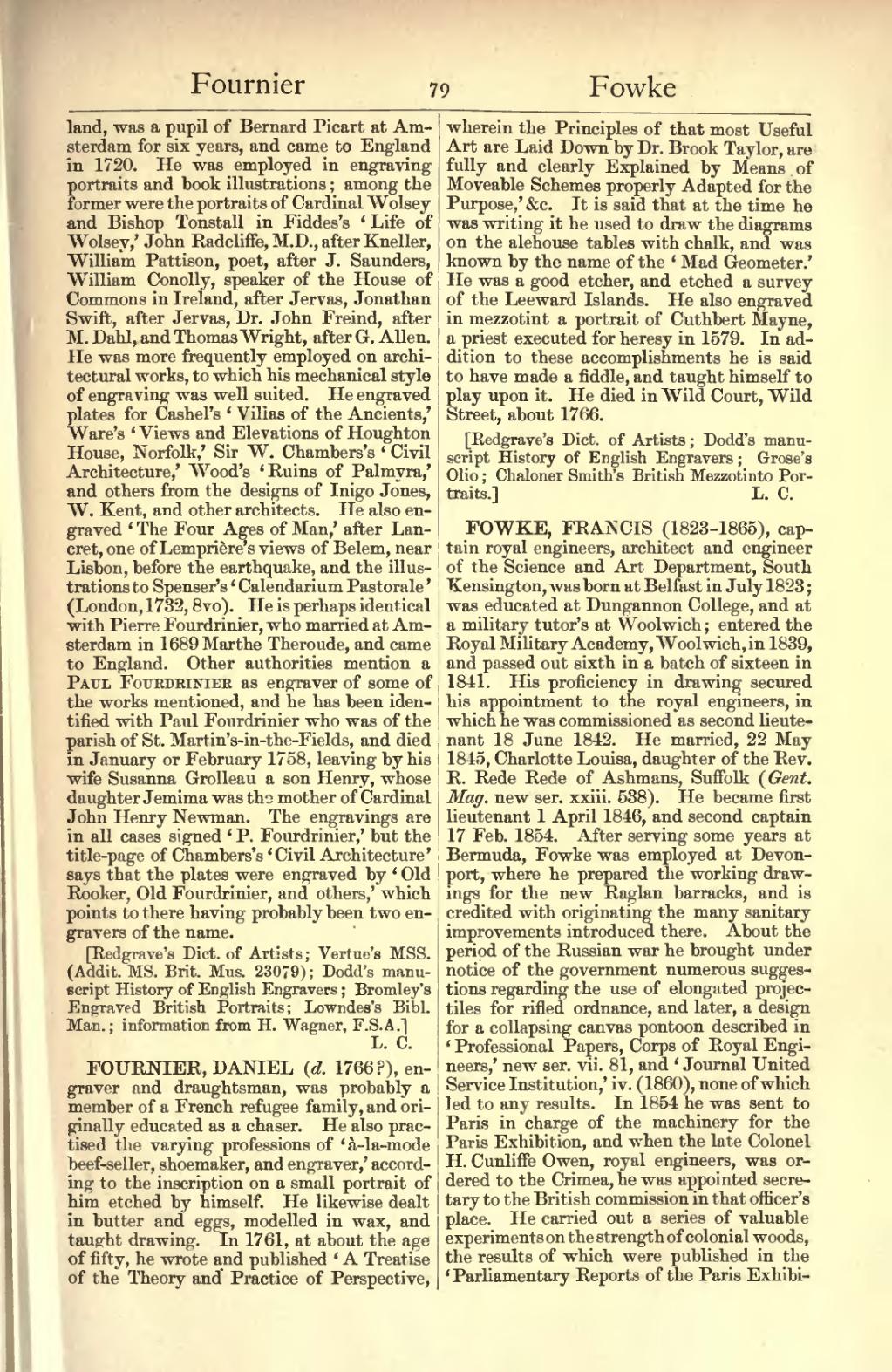land, was a pupil of Bernard Picart at Amsterdam for six years, and came to England in 1720. He was employed in engraving portraits and book illustrations; among the former were the portraits of Cardinal Wolsey and Bishop Tonstall in Fiddes's ‘Life of Wolsey,’ John Radcliffe, M.D., after Kneller, William Pattison, poet, after J. Saunders, William Conolly, speaker of the House of Commons in Ireland, after Jervas, Jonathan Swift, after Jervas, Dr. John Freind, after M. Dahl, and Thomas Wright, after G. Allen. He was more frequently employed on architectural works, to which his mechanical style of engraving was well suited. He engraved plates for Cashel's ‘Villas of the Ancients,’ Ware's ‘Views and Elevations of Houghton House, Norfolk,’ Sir W. Chambers's ‘Civil Architecture,’ Wood's ‘Ruins of Palmyra,’ and others from the designs of Inigo Jones, W. Kent, and other architects. He also engraved ‘The Four Ages of Man,’ after Lancret, one of Lemprière's views of Belem, near Lisbon, before the earthquake, and the illustrations to Spenser's ‘Calendarium Pastorale’ (London, 1732, 8vo). He is perhaps identical with Pierre Fourdrinier, who married at Amsterdam in 1689 Marthe Theroude, and came to England. Other authorities mention a Paul Fourdrinier as engraver of some of the works mentioned, and he has been identified with Paul Fourdrinier who was of the parish of St. Martin's-in-the-Fields, and died in January or February 1758, leaving by his wife Susanna Grolleau a son Henry, whose daughter Jemima was the mother of Cardinal John Henry Newman. The engravings are in all cases signed ‘P. Fourdrinier,’ but the title-page of Chambers's ‘Civil Architecture’ says that the plates were engraved by ‘Old Rooker, Old Fourdrinier, and others,’ which points to there having probably been two engravers of the name.
[Redgrave's Dict. of Artists; Vertue's MSS. (Addit. MS. Brit. Mus. 23079); Dodd's manuscript History of English Engravers; Bromley's Engraved British Portraits; Lowndes's Bibl. Man.; information from H. Wagner, F.S.A.]
FOURNIER, DANIEL (d. 1766?), engraver and draughtsman, was probably a member of a French refugee family, and originally educated as a chaser. He also practised the varying professions of ‘à-la-mode beef-seller, shoemaker, and engraver,’ according to the inscription on a small portrait of him etched by himself. He likewise dealt in butter and eggs, modelled in wax, and taught drawing. In 1761, at about the age of fifty, he wrote and published ‘A Treatise of the Theory and Practice of Perspective, wherein the Principles of that most Useful Art are Laid Down by Dr. Brook Taylor, are fully and clearly Explained by Means of Moveable Schemes properly Adapted for the Purpose,’ &c. It is said that at the time he was writing it he used to draw the diagrams on the alehouse tables with chalk, and was known by the name of the ‘Mad Geometer.’ He was a good etcher, and etched a survey of the Leeward Islands. He also engraved in mezzotint a portrait of Cuthbert Mayne, a priest executed for heresy in 1579. In addition to these accomplishments he is said to have made a fiddle, and taught himself to play upon it. He died in Wild Court, Wild Street, about 1766.
[Redgrave's Dict. of Artists; Dodd's manuscript History of English Engravers; Grose's Olio; Chaloner Smith's British Mezzotinto Portraits.]
FOWKE, FRANCIS (1823–1865), captain royal engineers, architect and engineer of the Science and Art Department, South Kensington, born at Ballysillan 7 July 1823, was educated at Dungannon College, and at a military tutor's at Woolwich; entered the Royal Military Academy, Woolwich, in 1839, and passed out sixth in a batch of sixteen in 1841. His proficiency in drawing secured his appointment to the royal engineers, in which he was commissioned as second lieutenant 18 June 1842. He married, 22 May 1845, Louisa Charlotte, daughter of the Rev. R. Rede Rede of Ashmans, Suffolk (Gent. Mag. new ser. xxiii. 538). He became first lieutenant 1 April 1846, and second captain 17 Feb. 1854. After serving some years at Bermuda, Fowke was employed at Devonport, where he prepared the working drawings for the new Raglan barracks, and is credited with originating the many sanitary improvements introduced there. About the period of the Russian war he brought under notice of the government numerous suggestions regarding the use of elongated projectiles for rifled ordnance, and later, a design for a collapsing canvas pontoon described in ‘Professional Papers, Corps of Royal Engineers,’ new ser. vii. 81, and ‘Journal United Service Institution,’ iv. (1860), none of which led to any results. In 1854 he was sent to Paris in charge of the machinery for the Paris Exhibi-
